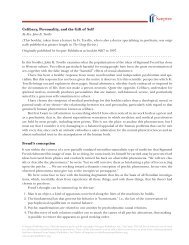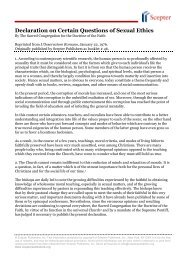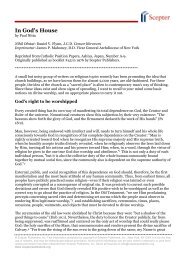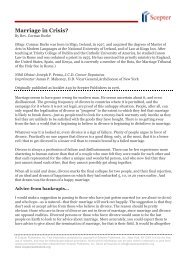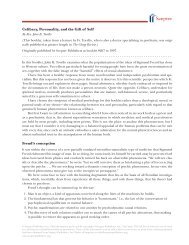by Joseph Soria - Scepter Publishers
by Joseph Soria - Scepter Publishers
by Joseph Soria - Scepter Publishers
You also want an ePaper? Increase the reach of your titles
YUMPU automatically turns print PDFs into web optimized ePapers that Google loves.
the virtue of order we need to practice with constancy a generous spirit of mortification, and to know how<br />
to put the things that we have used back in their places. Living the virtue well entails sacrificing oneself and<br />
taking, when necessary, the extra time to put a thing in its proper place and not just back where we happened<br />
to find it. This also includes the small mortification of offering to God the aggravation of getting up<br />
from the table to put back, in the bookcase or filing cabinet, the book or file folder that we are not going<br />
to use again.<br />
It’s true that these little details take time (really very little time, hardly more than a few seconds), but in<br />
fact one loses much more time trying to find something that is out of place. Unfortunately, someone was not<br />
far off the mark when he jokingly described many office desks as wastepaper baskets with drawers.<br />
Let’s look at four questions that business efficiency experts have used as a rule of thumb for determining<br />
orderliness. If our work is quite different from a typical office situation we will have to make adjustments,<br />
but even so these questions can be helpful for anyone.<br />
• Have I ever had to interrupt my dictating or writing of a letter to search for essential texts or documents<br />
connected with the matter?<br />
• Do I spend more time gathering together the needed documents for a project than actually working<br />
on it?<br />
Do documents frequently go astray and turn up days later in very unexpected places?<br />
• Do I ever have to push things aside to make space on my desk for a paper I want to work on?<br />
A “yes” to any of those questions suggests something to be desired in terms of order.<br />
Material creation has to serve as our stairway to ascend to God. In this way every small thing can become<br />
great, and converted into an occasion to live our faith, our hope, and our love. We may thus offer “a flower<br />
for Mary: the books in good order, the ashes in the ash tray, the papers in the file, the table free of crumbs,<br />
the neckties together, the clothes well arranged, shoes in pairs, the closets closed, etc.”<br />
Order in our activities<br />
The same reasons cited for creating order in our material surroundings can serve as a basis for ordering<br />
our activities.<br />
It’s important to have a basic daily schedule to organize our activities and help us avoid laziness, hectic<br />
improvisation, or senseless idleness. This is a matter of planning, but we need to be prudent and avoid rigidness,<br />
not forgetting, as St. Josemaria has reminded us, that “human undertakings, whether they are hard or<br />
simple, always have to count on a margin of the unforeseen; and that a Christian should never shut off the<br />
road of hope, or be forgetful of God’s Providence.”<br />
One key to order is simply taking care not to be slaves to our schedules at the expense of other important<br />
aspects of our lives. But this risk, which is real but probably less frequent than one might think, should<br />
not prevent us from laying out a sensible plan for the use of our time. Among the basic elements of such a<br />
plan would be set times for getting up and going to bed, time dedicated to work, to the means of growth in<br />
our spiritual life, to our family, to cultural development and rest, and to social relations and friendships.<br />
To use a metaphor, a good schedule is like a hand. In order for our hand to do its job properly, it needs<br />
its five fingers, and each has to be the proper length; none can be too long or too short. (It would likely be<br />
a greater handicap to have a finger eight inches long than to have one missing altogether.) The five fingers<br />
may represent our religious duties (the middle finger), our family duties (the ring finger), those of our<br />
profession (the index finger), those connected with rest and cultural development (the little finger), and<br />
those of our social nature (the thumb).<br />
© <strong>Scepter</strong> <strong>Publishers</strong>, Inc. This information protected <strong>by</strong> copyright of <strong>Scepter</strong> <strong>Publishers</strong>, Inc., New York, NY USA. It is for the free use of readers,<br />
and may be redistributed without permission. None of this information can be sold, either in electronic or print form, unless permission<br />
has been obtained from <strong>Scepter</strong> <strong>Publishers</strong>, Inc. Direct all inquiries to info@scepterpublishers.org.<br />
www.scepterpublishers.org



